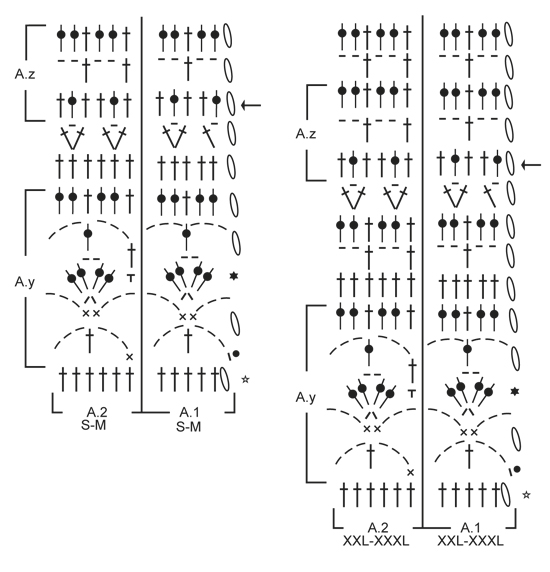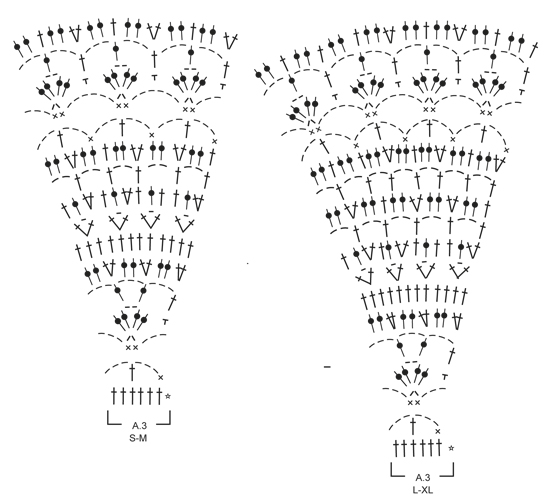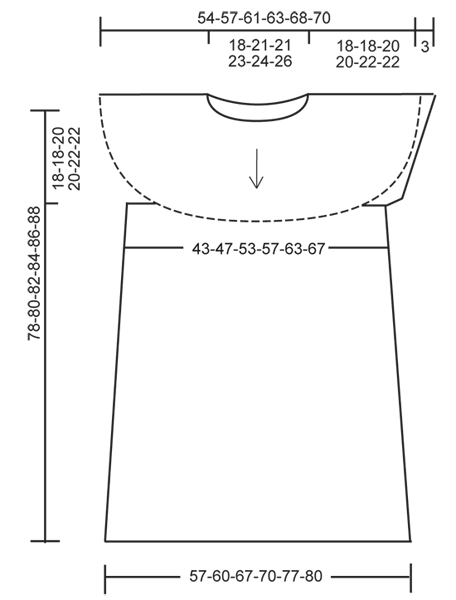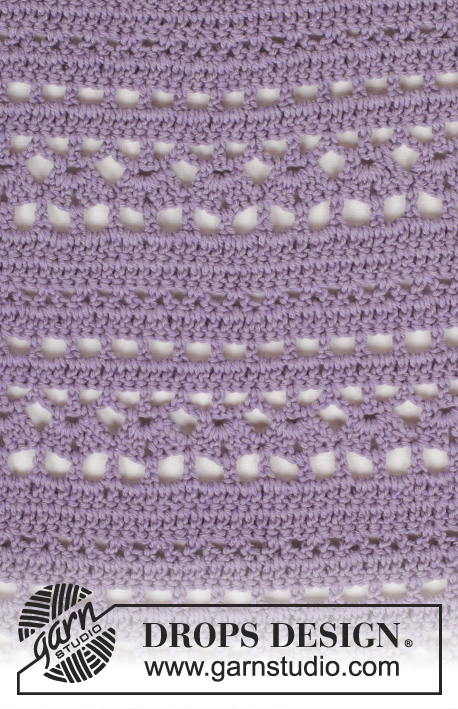Comments / Questions (33)
![]() Anette Schwarz wrote:
Anette Schwarz wrote:
Hallo liebes Drops- Team, Wie kommt es, dass ich für die Anleitung für dieses Kleid auf einer anderen Webseite 3€ bezahlen muss? Lg
11.07.2023 - 11:08DROPS Design answered:
Liebe Anette, Alle unsere Modelle sind kostenlos auf unserer Website verfügbar. Sie können sie hier einsehen und als PDF herunterladen. Viele Spass beim häkeln!
27.07.2023 - 10:06
![]() Ute Wilson-Oertel wrote:
Ute Wilson-Oertel wrote:
Hi, the size is XL . The pattern A3 confuses me, I do not know how to proceed or how it repeats itself . It would help me, if I knew how the pattern is continuing. Thanks a lot
27.02.2023 - 10:43DROPS Design answered:
Dear Mrs Wilson-Oertel, you just have to work all diagrams at the same time in this order: A.1 over the first 6 tr, A.2 over the next 18 tr (= 3 times in total), A.3 over the next 12 tr (= 2 times in total), A.2 over the next 12 tr (= 2 times), A.3 over the next 12 tr (= 2 times), A.2 over the next 42 tr (= 7 times), A.3 over the next 12 tr (= 2 times), A.2 over the next 12 tr (= 2 times), A.3 over the next 12 tr (= 2 times), A.2 over the last 18 tr (= 3 times) = 156 trebles. Then work 2nd row all diagrams, 3rd row all diagrams etc... You should increase only in A.3 - insert markers between diagrams/repeats can help you tracking the number of sts. Can this help?
27.02.2023 - 11:25
![]() Ute Wilson-Oertel wrote:
Ute Wilson-Oertel wrote:
Hallo, A3 habe ich Probleme. Bei den Reihen mit den Stäbchen, weiß ich nicht wie es danach weiter geht, da es abgehackt ist und ich nicht weiß, ob der Anfang mitgezählt wird. Eine Reihe beginnt mit 5 Stäbchen ,dann werden am Ende 8 Stäbchen angezeigt und dann? Wie fahre ich weiter? Danke
26.02.2023 - 13:19
![]() Ute Wilson-Oertel wrote:
Ute Wilson-Oertel wrote:
Hallo, A3 habe ich Probleme. Bei den Reihen mit den Stäbchen, weiß ich nicht wie es danach weiter geht, da es abgehackt ist und ich nicht weiß, ob der Anfang mitgezählt wird. Z.B. Reihe 13 beginnt mit 5 Stäbchen ,dann werden am Ende 8 Stäbchen angezeigt und dann? Wie fahre ich weiter? Danke
26.02.2023 - 13:18DROPS Design answered:
Liebe Frau Wilson-Oertel, können Sie uns bitte mitteilen, welche Größe Sie häkeln? Da es sind 3 verschieden A.3, würde es uns helfen, Ihnen dann weiterzuhelfen. Danke im voraus für Ihr Verständnis.
27.02.2023 - 10:28
![]() Tracey wrote:
Tracey wrote:
I completed 3 rd row now. So now it asking when a1 a2 have been worked 1 time vertically repeat them upwards. So do I do a1 row then a2. Then a1 then a2. Or just go up on a2 chart thanks.
29.11.2019 - 14:40DROPS Design answered:
Dear Tracey, you continue working the same diagrams as for previous round, ie A.1, A.2, A.3 , etc... in the same order as before, working each row in each diagram. You are increasing stitches in A.3, while the number of stitches in A.1 and A.2 will remain the same. Happy crocheting!
29.11.2019 - 15:48
![]() Tracey wrote:
Tracey wrote:
Hi I have done 1 row as 4 tr and skip stitch. 4 tr. to end. Then second row I increased so I have 120 now. Instead of 104. So I know that right. But now it says continue to work as follows. Work a1 over the first 6 tr. is that 1 row Cause if I do 30 times tr 5 times. And the other stitches aswell. It not going to fit on the same row. As I only got 120 sts. As I’m doing the small size. Plz help with diagram. I’m still learning to do crochet.
29.11.2019 - 12:25DROPS Design answered:
Dear Tracey, work first row each diagram at a time, ie row 1 in A.1 over the first 6 sts, then repeat row 1 in A.2 a total of 2 times (= over the next 12 sts), row 1 in A.3 over the next 12 sts (= 2 times in width), and so on. On next round, work row 2 each diagram, then row 3 and so on. read more here. Happy crocheting!
29.11.2019 - 13:00Irma wrote:
: Work A.1 over the first 6 dc, A.2 over the next 12-12-12-18-24-24 dc (= 2-2-2-3-4-4 times in total), A.3 over the next 12 dc (= 2 times in total), A.2 over the next 6-6-6-12-12-12 dc (= 1-1-1-2-2-2 times), A.3 over the next 12 dc (= 2 times), ............... A.3 over the next 12 dc (= 2 times), A.2 over the last 12-18-18-18-24-30 dc (= 2-3-3-3-4-5 times) After above round how many stitches should i have for xl.
28.09.2017 - 15:45DROPS Design answered:
Dear Irma, after this round, you will still have 156 sts in XL,ie as before since you work 1 st in the st from previous row, see diagram. Happy crocheting!
28.09.2017 - 17:22
![]() Afshan Raheel wrote:
Afshan Raheel wrote:
How many stitches after row 2?
27.09.2017 - 18:43DROPS Design answered:
Dear Mrs Afsha, after row 1 you will have the same number of sts as you will not increase in row 1 - It can be a good idea to insert a marker between each repetition so that you can easily follow your work and the diagram. Happy crocheting!
28.09.2017 - 09:31
![]() Afsha Raheel wrote:
Afsha Raheel wrote:
Plz help me with 2nd row of yoke. It will be double crochet in each stich ? If we do not divide in a1 a2 a3? And 3rd row. What is above a1 6 dc? If its according to diagram then what does row 2 mentions a2 4 time a3 2 time????
27.09.2017 - 18:22DROPS Design answered:
Dear Mrs Afsha, on 2nd round on yoke you will work 1st row in each diagram as stated, ie in the 2 larger sizes you will work 2nd round as follows: A.1 over the first 6dc, A.2 over the next 24dc (= 4times in total = repeat 4 times in width row 1 in A.2)), A.3 over the next 12dc (= 2times in total), A.2 over the next 12 dc (= 2 times), A.3 over the next 12 dc (= 2 times), A.2 over the next 54-60 dc (= 9-10 times), A.3 over the next 12 dc (= 2 times), A.2 over the next 12 dc (= 2 times), A.3 over the next 12 dc (= 2 times), A.2 over the last 24-30 dc (= 4-5 times). Happy crocheting!
28.09.2017 - 09:30Asraa wrote:
Hi. I have just completed A3 and the 5th rounds of A1 and A2 for the size medium. However the count of my tr stitches is only 196.If I count the chain stitches in between then the stitch count goes well over 252. However if I apply some mathematics and get the stitch by multiplying the number of tr stitches in each mode (A1,A2,A3) by the number of times they are repeated it comes out as 196= 2 (for A1) +26(for A2) +168(for A3). Kindly help me with this.
30.08.2017 - 19:22DROPS Design answered:
Dear Asraa, by the time you finish the last row of pattern A.3 you should have the following stitch counts: A.1 (6 sts), A.2 (12 sts), A.3 (2 x 21= 42 sts), A.2 (6 sts), A.3 (42 sts), A.2 (36 sts), A.3 (42 sts), A.2 (6 sts), A.3 (42 sts) A.2 (18 sts) that adds up to 252 sts, hich is the number of stitches you have to continue to work with. I hope this helps. Happy Crocheting!
31.08.2017 - 06:12
Toulouse#toulousedress |
|||||||||||||||||||||||||||||||
|
|
|||||||||||||||||||||||||||||||
Crochet DROPS dress with lace pattern and round yoke, worked top down in ”Cotton Merino”. Size: S - XXXL.
DROPS 165-36 |
|||||||||||||||||||||||||||||||
|
CROCHET INFO: On every tr round, replace first tr with 3 ch and finish round with 1 sl st in first 3rd ch from beg of round. INCREASE TIP: Inc 1 tr by working 2 tr in 1 tr. PATTERN: See diagrams A.1 to A.3. Choose diagram for correct size. A.1 shows how pattern beg and ends. ---------------------------------------------------------- YOKE: Worked in the round, top down, beg mid back. Work 128-138-138-163-168-173 ch on hook size 4 mm with Cotton Merino and form a ring with 1 sl st in first ch. Work next round as follows: Work 3 ch (= 1 tr) - READ CROCHET INFO, 1 tr in first ch from ch-ring, 1 tr in each of the next 2 ch, * skip 1 ch, 1 tr in each of the next 4 ch *, repeat from *-* the entire round, finish with 1 sl st in 3rd ch at beg of round = 104-112-112-132-136-140 tr. On next round, inc 16-20-20-24-44-52 tr evenly - READ INCREASE TIP = 120-132-132-156-180-192 tr. Continue to work as follows: Work A.1 over the first 6 tr, A.2 over the next 12-12-12-18-24-24 tr (= 2-2-2-3-4-4 times in total), A.3 over the next 12 tr (= 2 times in total), A.2 over the next 6-6-6-12-12-12 tr (= 1-1-1-2-2-2 times), A.3 over the next 12 tr (= 2 times), A.2 over the next 30-36-36-42-54-60 tr (= 5-6-6-7-9-10 times), A.3 over the next 12 tr (= 2 times), A.2 over the next 6-6-6-12-12-12 tr (= 1-1-1-2-2-2 times), A.3 over the next 12 tr (= 2 times), A.2 over the last 12-18-18-18-24-30 tr (= 2-3-3-3-4-5 times). NOTE: In size S+XL+XXL beg round a little towards one side so that pattern fits. Continue pattern like this. REMEMBER THE CROCHET TENSION! When A.1/A.2 have been worked 1 time vertically, repeat them upwards. When A.3 has been worked 1 time vertically, there are 240-252-292-316-340-352 tr on round. Piece measures approx. 18-18-20-20-22-22 cm (measured from neck edge). Now work as follows (= 6th round in A.1/A.2): Work 1 tr in each of the first 39-39-44-50-56-56 tr (= half back piece), work 6-6-8-8-8-8 ch, skip 48-48-58-64-64-64 tr (= armhole), work 1 tr in each of the next 72-78-88-94-106-112 tr (= front piece), work 6-6-8-8-8-8 ch, skip 48-48-58-64-64-64 tr (= armhole), work 1 tr in each of the last 33-39-44-44-50-56 tr = 144-156-176-188-212-224 tr and 6-6-8-8-8-8 ch in each side of piece (= 156-168-192-204-228-240 sts in total). Insert 1 marker in piece, NOW MEASURE PIECE FROM HERE. BODY: Work next round as follows (= 7th round in A.1/A.2): Work A.1 1 time, then work A.2 over the remaining 150-162-186-198-222-234 tr/ch (= 25-27-31-33-37-39 times in total in width). Continue working the pattern vertically. AT THE SAME TIME on round with arrow in diagram inc 12 tr evenly (i.e. work 2 tr in every 13th-14th-16th-17th-19th-20th tr) = 168-180-204-216-240-252 tr. Repeat A.2 2 times more in width. Repeat inc every 10 cm, adjust to inc on a round with tr, 3 more times = 204-216-240-252-276-288 tr. For every inc, repeat A.2 2 times more in width. After last inc, repeat A.2 33-35-39-41-45-47 times in total in width. When piece measures approx. 44-46-46-48-48-50 cm (from marker) – adjust so that last round is a round with tr, work A.y 3 times in total vertically. Then work A.z 1 time vertically. Piece measures approx. 78-80-82-84-86-88 cm in total from neck edge. Fasten off. SLEEVE EDGE: Worked in the round. Beg mid under sleeve. Work 1 sl st in 4th ch mid under sleeve, 3 ch, 1 tr in each of the next 2-2-4-4-4-4 ch, 1 tr in each of the 48-48-58-64-64-64 tr for sleeve AT THE SAME TIME dec 6-6-4-4-0-0 tr evenly and 1 tr in each of the last 3 ch cast on under sleeve = 48-48-62-68-72-72 tr. Work 2 rounds with 1 tr in every tr. Fasten off. Work a sleeve edge on the other sleeve. |
|||||||||||||||||||||||||||||||
Diagram explanations |
|||||||||||||||||||||||||||||||
|
|||||||||||||||||||||||||||||||

|
|||||||||||||||||||||||||||||||

|
|||||||||||||||||||||||||||||||

|
|||||||||||||||||||||||||||||||

|
|||||||||||||||||||||||||||||||
Have you finished this pattern?Tag your pictures with #dropspattern #toulousedress or submit them to the #dropsfan gallery. Do you need help with this pattern?You'll find 9 tutorial videos, a Comments/Questions area and more by visiting the pattern on garnstudio.com. © 1982-2025 DROPS Design A/S. We reserve all rights. This document, including all its sub-sections, has copyrights. Read more about what you can do with our patterns at the bottom of each pattern on our site. |
|||||||||||||||||||||||||||||||




















































Post a comment to pattern DROPS 165-36
We would love to hear what you have to say about this pattern!
If you want to leave a question, please make sure you select the correct category in the form below, to speed up the answering process. Required fields are marked *.